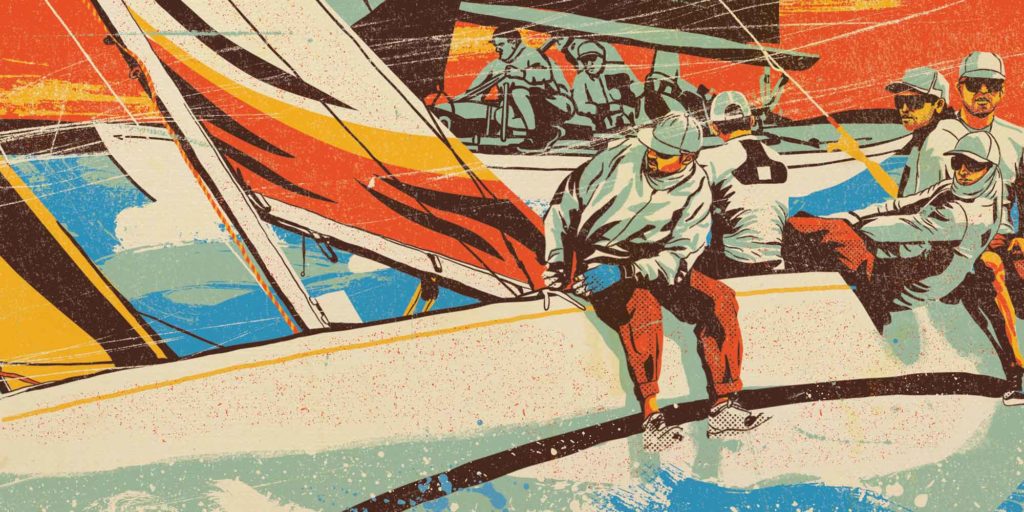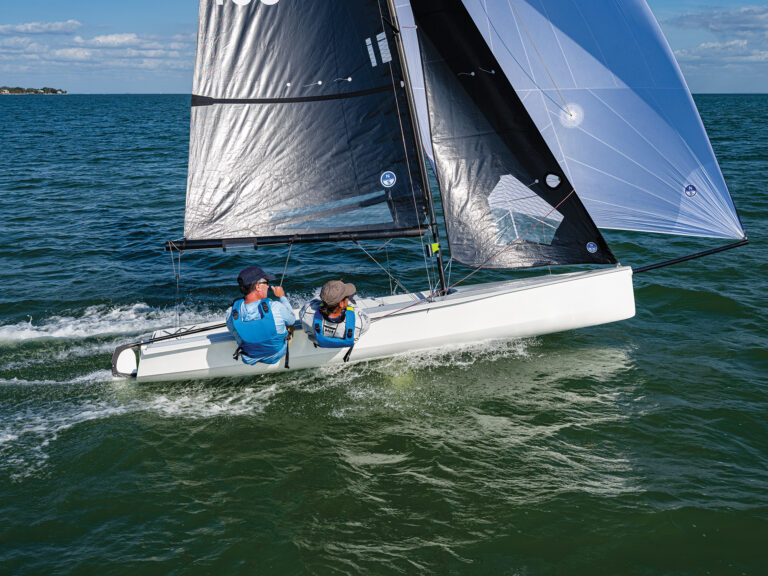
“All good up here?” I ask the bowman who is rotating off the boat we are rotating onto. It’s a courteous way of asking if I’ll run into any surprises or potential breakdowns as I get my playground in order. We’re midway through the Argo Bermuda Gold Cup Match Race Regatta. Our skipper, Taylor Canfield, and the rest of my teammates make quick pleasantries with the passing crew. They’re not as upbeat as we are. Perhaps they are not having as good of a day or just lost a match. With four matches going on at once, it’s hard to know how anybody is doing at any given moment.
“All aboard?” asks the “barge master” before sending us on our way, making room for the next set of teams to rotate.
As we push off the barge, our roles unfold. Putting the “Canfield” name placard onto the mainsail is not only first, it’s an honor badge, a patch that says who we are and who we fight for. I would think seeing one’s name, in big block letters on the sail, would be a major motivator, but it doesn’t faze Canfield, who makes a game of putting it on smoothly as I hold one side in place. Our tactician, Mike Buckley, comments, “Is that the best you can do?”
The placard isn’t perfectly smooth and requires a slight adjustment. I notice the D on one side of the placard has peeled off and has been replaced by a faded D crafted by a permanent marker. I make a mental note: Fix that before tomorrow. It doesn’t look cool, which makes me think of my dad’s Rule No. 1: “If you don’t look cool, you probably aren’t.”
The vibe on board is relaxed. Canfield plays around with the tiller, commenting on the differences from boat to boat. He wonders aloud why this one has a stainless-steel tiller extension. Some tillers turn too far, some not far enough. That’s a trait worth noting before the next dial-up.
Our jib and spinnaker trimmer George Peet and mainsail trimmer Victor Diaz de Leon check the bilge for water while I stare at the mess the previous bowman left me. The starting signal accompanying the foxtrot flag reminds us that we still have a fair amount of prep work to do before our start. Foxtrot is my friend, signaling that the first sequence is two minutes away. It also signals the start of me forgetting to start my watch, repeatedly.
Canfield always gets his watch going, even without warning. He smiles, probably thinking to himself that’s why he’s in the back of the boat and I’m on the bow. The jokes, jabs and endless nicknames slow to a dull roar, and it’s mostly business from here. Diaz de Leon hops into the cockpit and goes straight to the jib halyard, which exits at the base of the mast. I’m sure he enjoys going belowdecks at the weather mark to drop the jib and at the leeward mark to re-hoist it.
Peet calls halyard tension so that Diaz de Leon can tape a good mark on it. It’s not easy at a rushed leeward mark to be down below, blind to what’s happening above, trying to get a jib halyard onto a winch and find your mark, not one placed by the previous crew. Luckily for me, the jib-lead placement for Peet is easy — all the way forward. If possible, even partially off the front of the track. Canfield reminds us, again, that he is looking for all the power we can give him. He looks on with a watchful eye.
“Ninety-nine percent trim,” says Peet. That’s code for “perfect.” The final 1 percent is reserved for a higher, slower-velocity-made-good mode.
Simultaneously, Buckley and Diaz de Leon assess mainsail trim and add tape marks as well. These IODs are odd. The mainsheet is at the back of the boom, and the traveler is forward of it. On the practice day, we figured out that Buckley should be in the back, pulling the main in and out at mark roundings, and that Diaz de Leon should be up front working the traveler along with an assortment of other controls.
Canfield adds his input on how the boat feels and cautions about overtrimming. “Trust me,” Diaz de Leon says, reminding Canfield that he proved himself at Congressional Cup with a different trim style than others. The banter continues as Taylor explains in more detail how the boat feels different. Diaz de Leon, confident in his setup, lets Canfield know again that he doesn’t need to worry.
“Trust me, Taylor,” he says in his Venezuelan accent.
Meanwhile, I’ve been cleaning up my bow area, keeping my head low and avoiding the friendly verbal cannonballs volleying in the cockpit. At this point I’m reminded that if I put my ponytail through my hat, I will be less likely to lose it.
Moments later, Buckley announces they will shave my head if we win this event. I nicely, but in colorful detail, let him know I would kill him if that ever happened. An awkward moment of silence follows. Maybe that was a little dark. Over the top? Unlikely, but you never know where the edge is until you peer over the cliff. I think, You bring me into a winning America’s Cup Team … maybe.
The boat doesn’t feel as if it’s going well. Someone is pinching. As I look up from my bow prep, I find Buckley and Canfield scanning the racecourse for more wind and a favored side rather than sailing to the telltales. A plan for the racecourse evolves. Diaz de Leon was brought in for his main trimming skills and tactical prowess, and he adds his observations. When three or four smart guys in the afterguard agree on something, it gives you a great confidence in their ability to execute the plan.
By this time, we’re a fair amount up the course. I often find myself as the voice of reason. I’m the oldest aboard, so it’s a good role for me. I remind the lads that we have to get back to the starting area. We put up the spinnaker. This is solely to make sure the previous crew didn’t rip it and to check the topping lift height. With an IOD, this prep work also teaches us where the various cleats are. Almost comically, the cleats and leads are different from boat to boat. For most of us, it’s pretty easy, but for Diaz de Leon, it’s a mess. After a few choice words, everything is under control, memorized or labeled.
“Topping lift, Vic.” “Hey Vic, topping lift.” “Victor, topping lift!” I say, my voice getting louder each time. “Oh, copy,” he shouts back. Peet shakes his head with humorous disappointment.
Who needs enemies with friends like this, right?
When three or four smart guys in the afterguard agree on something, it gives you a great confidence in their ability to execute the plan.
As we near the starting area, Buckley notices one gate is favored. Quietly and without command, I call for the topping lift to be uncleated and to store the pole before dropping the kite. The goal is to get it down, clean, void of tears and dry, and run the tapes before Taylor decides to head up and add to the apparent windspeed. As a former bowman now finding myself back on the foredeck occasionally, I grumble under my breath at any helmsman who makes things even 1 percent harder than it needs to be during spinnaker drops that aren’t rushed.
“What was that?” Canfield asks out of the blue.
“Nothing,” I reply. “All good.”
Peet and I share an acknowledging smirk. We both know that is not a conversation worth having while we’re trying to get into the race at hand.
The banter relaxes as we close in on our final segment of the pre-race routine. We sail around the start line, making sure not to interfere with matches already in process. We check laylines, time and distances from the line. The trimmers make last-minute adjustments to the settings.
Rather then discuss the aerodynamic implications of an extra few millimeters of backstay, we hear, “Backstay at two.”
“Copy, backstay at two.”
This quickly becomes a new theme that breaks tenuous moments. “Vang at two.” “Traveler at two.”
We finish our pre-race prep with the ritual of chewing a new piece of gum and a fist bump. “Let’s have a good one, boys,” Buckley says.
Fast-forward. Close to the finish line of our first loss of the series, Buckley starts the dialogue of where it went wrong. Peet has a colorful yet likely accurate assessment of the issues. Behind at the start, to weather in light air, down-speed, tacked into a light header, etc. Sounds about right. Canfield finds himself with little to add, leaving him uncharacteristically quiet.
Sometimes, it just doesn’t go your way, but that couldn’t be it, so we search for more plausible reasons. Ah, gum. Yes gum.
Buckley has a problem, er, ritual of chewing a new piece of gum — in fact, sometimes, many pieces — before each race, making sure there is always one left over to offer to the sea. The sea only recognizes the offering if the gum is bounced at high velocity off the deck.
After our first loss, it dawns on us. We were out of gum. No bounce. No offering. With little time between matches, we sail past the VIP boat, where I jump off, run to the top observation deck and ask a crowd of spectators if they have any gum. Luckily, race commentator Tucker Thompson does. With a twinkle in his eye and a happy sneer on his mouth, he hands over just enough to get us through the day.
The sail in at the end of the day is short. Just enough time to start the cleanup and reflect on a good day of sailing. Once docked, it’s all we can do to roll the sails, collect our water bottles and our gear and return our name placards.
“We go,” Buckley says, indicating the day is done.
The pattern, dear reader, is patently clear when sailing with Canfield and company. Through the playtime, there’s always learning, practicing or accomplishing a goal. There’s trust and adherence to processes and job assignments. Trust in one’s teammates is crucial as well, trust everyone will do their job but always be ready to help others. Details matter, of course, as does having fun.









